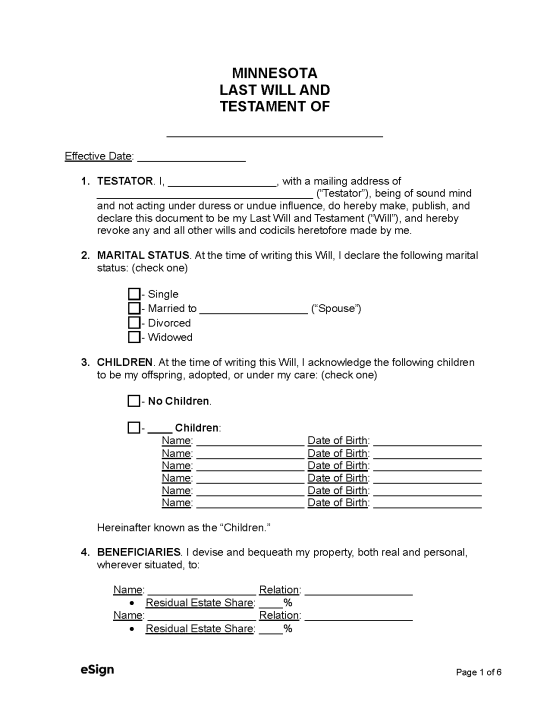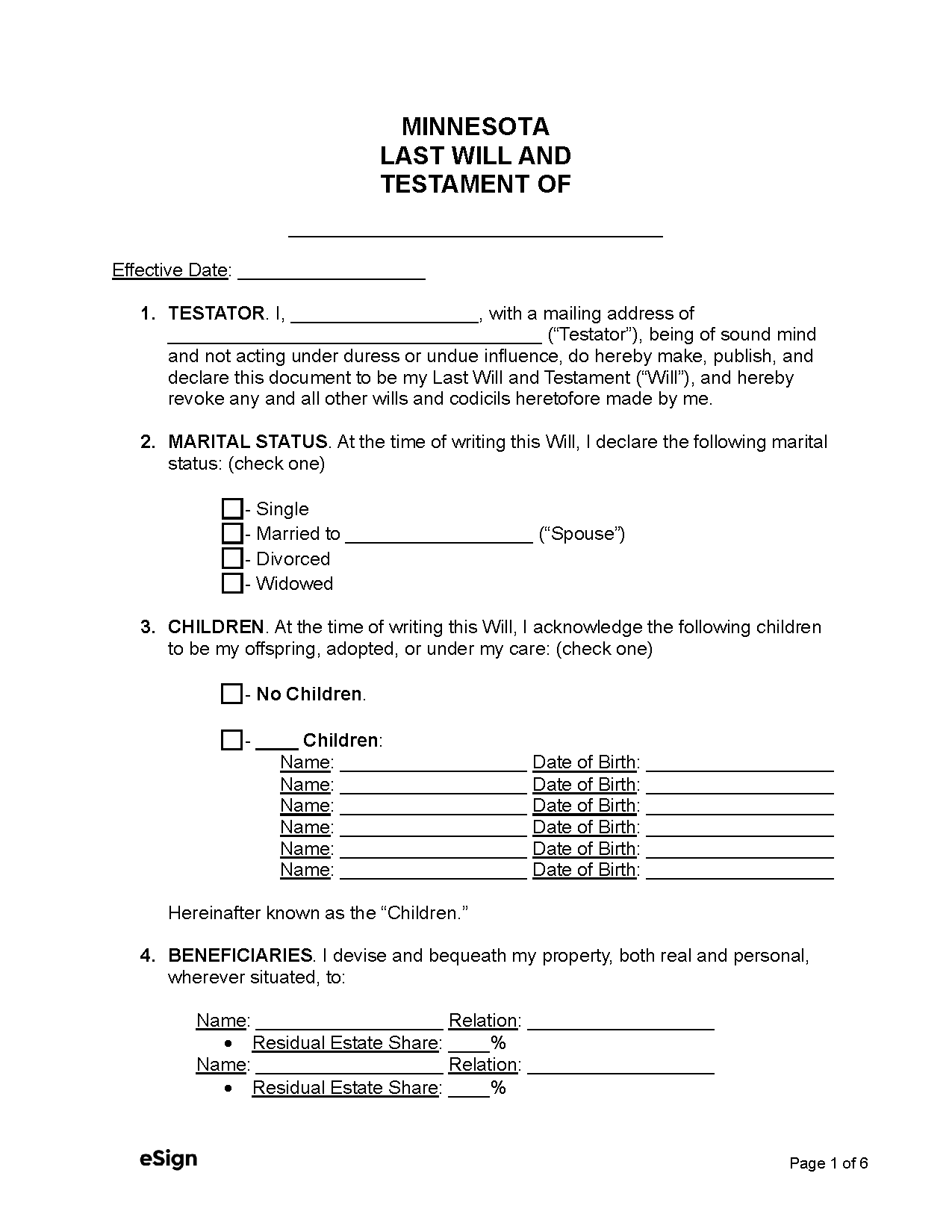State Laws
A will may be created by an individual who is of sound mind and at least 18 years or older.[1]
Holographic Wills – Handwritten wills must meet the same requirements as standard wills and be signed by the testator (or their authorized representative) and two witnesses.[2]
Revocation – A will may be revoked by executing a new will or destroying the original will.[3]
Signing Requirements – Wills must be signed by the testator (or by an authorized individual in their presence) and two witnesses.
Probate Process in Minnesota (7 steps)
The time limit for probating a will is three years following the testator’s death.[4]
The following is meant to be a general overview of the probate process. It is recommended that executors/personal representatives consult with an attorney if they’re unsure of any step.
1. Application Filing
If the total value of a decedent’s estate is $75,000 or less and does not include real property, the Affidavit of Collection of Personal Property (or “small estate affidavit”) may be used to collect and distribute assets instead of the estate going through probate.[5]
There are two types of probate in Minnesota; formal and informal, with informal being the most common. Formal probate is only reserved for more complicated cases, such as those with a missing will, disputes between beneficiaries, or an insolvent estate.[6]
The person named in the will to be the personal representative (also known as the “executor”) must file the following documents with the probate registrar to ask for their formal appointment as representative and for approval of informal probate:[7]
- Application for Informal Probate of Will and For Informal Appointment of Personal Representative (PRO802)
- Acceptance of Appointment as Personal Representative and Oath by Individual (PRO902)
- Original will – The original will drafted by the decedent.
- Death certificate – A copy of the decedent’s death certificate and that of any beneficiaries that died before the decedent.
- Filing fee – A filing fee, or if the applicant cannot afford it, they may apply for a fee waiver.
2. Notices
- Notice of Informal Probate of Will and Appointment of Personal Representative and Notice to Creditors – The probate registrar issues this form after filing the application. Copies of the notice should be sent to the beneficiaries, creditors, and other parties named in the Application for Informal Probate.
- Newspaper publication – The Notice of Informal Probate must run for two weeks in a newspaper in the county where the application is filed to inform the public and to allow creditors to present claims.[8],[9]
- Notice to Spouse and/or Children (PRO906) – If the decedent had a spouse or children, a copy of the document must be mailed to the spouse and each child.
- Notice to Commissioner of Human Services Regarding Possible Claims (PRO905) – This notice must be mailed with a copy of the Notice of Informal Probate to:
Commissioner of Human Services
Attn: Special Recovery Unit/Estate Notice
P.O. Box 64995, St. Paul, MN 55164-0995
3. Affidavits
The applicant must complete and file the Affidavit of Mailing (PRO803) for each party to whom the Notice of Informal Probate was delivered, as well as an Affidavit of Publication provided by the newspaper that published the notice.
An Affidavit of Mailing of Notice to the Commissioner of Human Services Regarding Possible Claims (PRO903) must also be completed and filed with the registrar.
Copies of the notices do not need to be filed with the registrar, only the affidavits.
4. Letters Testamentary
The registrar will issue Letters Testamentary after all the necessary documents have been filed, granting the applicant the authority to settle the estate. During estate administration, the personal representative is responsible for settling outstanding obligations, creating an inventory of the estate, collecting property, and other affairs.
Certified copies of the Letters Testamentary are generally needed for the personal representative to carry out their duties. There is a charge for each certified copy.
5. Inventory
The personal representative must collect the decedent’s property and list them in Inventory (PRO912) within six months of being appointed or within nine months of the decedent’s death (whichever is later). A copy should be provided to any surviving spouse, residuary distributees, and interested persons at their request.[10] Though not required, it is good practice to file the Inventory with the registrar.
After the Inventory is completed, the personal representative will need to settle the decedent’s taxes, debts, or claims. Parties with a claim to the estate can complete the Written Statement of Claim (PRO402) and send it to the personal representative.[11]
6. Taxes
The personal representative is responsible for paying the decedent’s income taxes for the year they passed away.[12] Furthermore, estate taxes will be owed if the gross value of all assets is equal to or greater than the estate tax threshold set by the Department of Revenue.
- Form M1 Individual Income Tax – The personal representative must enter their address and signature, and the decedent’s name followed by “DECD” and the date of death.[13] A copy of the Letters Testamentary must be included when filing the form with the Department of Revenue.
- Form M706, Estate Tax Return – This document must be filed with the Department of Revenue, if applicable.
- Form 706 – This document is required by the IRS for filing estate tax returns.
7. Closing Estate
Before the personal representative can distribute and close the estate, they must complete the following forms:
- Final Account and Proposal for Distribution (PRO913) – The personal representative must complete the Final Account within one year of being appointed, and it is recommended to file it with the registrar. Copies of the document should be provided to the decedent’s surviving spouse, residuary distributees, and interested parties.
- Affidavit of Service (PRO915) – This form should be completed to record which parties received which forms during administration.
Once the above forms have been issued and filed, the estate may be distributed to each beneficiary. The two remaining forms below must then be completed before the estate can close:
- Receipt for Assets by Distributee (PRO916) – Each beneficiary must receive this form after the estate has been distributed to indicate the assets they have received.
- Petition for Discharge of Personal Representative (PRO1304) – Once the court approves this petition, the personal representative is discharged from their position.
The estate can only be closed after it has been at least four months since the Notice to Creditors was published.[14]
Sources
- § 524.2-501
- § 524.2-502
- § 524.2-507
- § 524.3-108
- § 524.3-1201(a)(1)
- Recovering MA Funds in Probate
- Starting a Case: Informal Probate with a Will
- § 524.3-310
- § 524.3-801(a)
- § 524.3-706
- § 524.3-804
- Tax Responsibilities for Personal Representatives
- Filing on Behalf of a Deceased Taxpayer
- § 524.3-1003(a)

